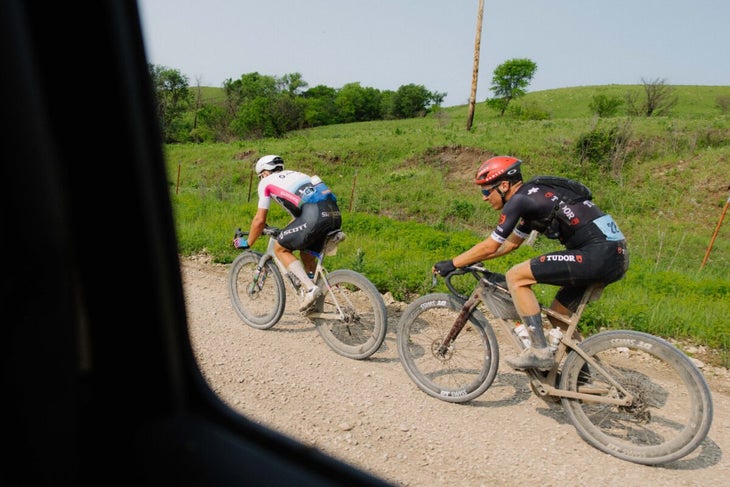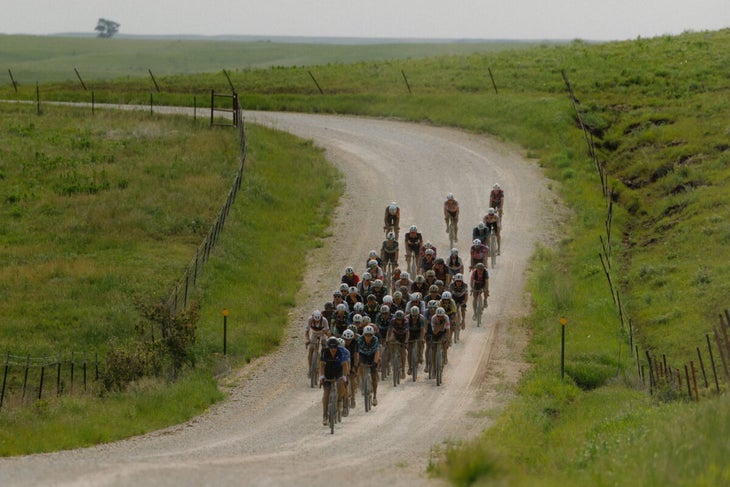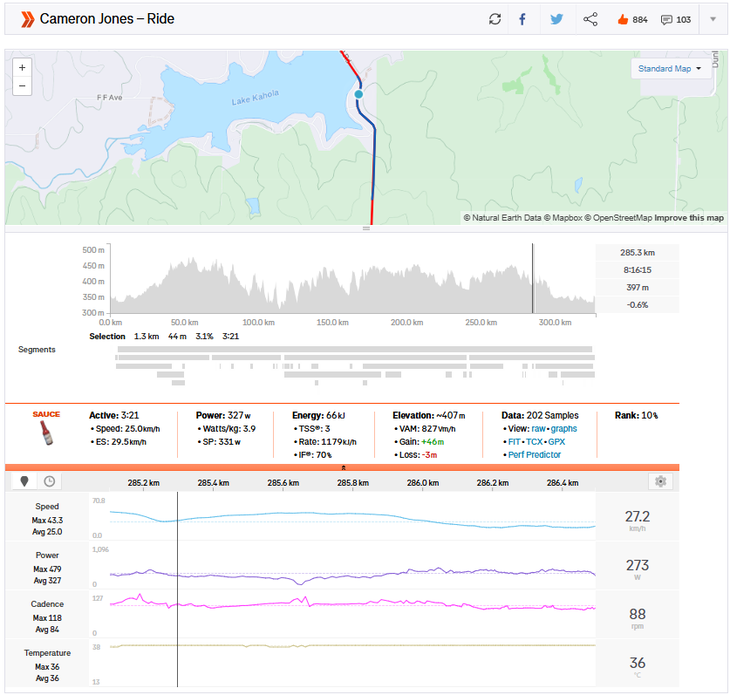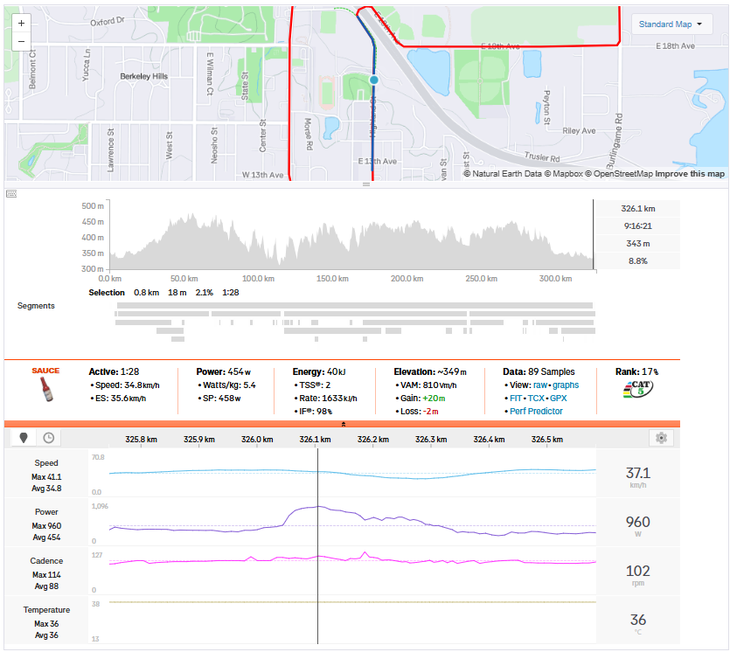Less than a quarter of the way through Unbound Gravel, Cameron Jones and Simon Pellaud made their way into a two-man breakaway. More than 165 miles remained, so few believed this would be the winning move. But as the pedals turned, the duo’s gap grew to more than seven minutes.
Attacks came and went in the peloton, but the breakaway maintained their multi-minute advantage with just 35 miles to go. In the end, Jones dropped Pellaud with a simple acceleration — it was less “dropping the hammer” and more “dropping the feather.”

Jones’ performance was one for the history books, and we’ll dive into the numbers in a minute. In the women’s race, Karolina Migoń attacked from the breakaway to win by more than eight minutes. Her time of 10 hours 3 minutes and 54 seconds would have been fast enough to win Unbound outright a few years ago. Here is how it happened.
Unbound Gravel is a race in which a lot can go haywire. Crashes, punctures, and mechanicals are part of the race — at least for most riders. Thus, getting into the early breakaway is a popular strategy. When you’re ahead of the peloton, you can avoid most of the chaos. You can also choose your own lines, set your own pace through a technical section, and maintain a steady tempo rather than responding to punchy attacks.

The early break strategy is such a popular one that it took more than two hours for the move to establish itself in the men’s race. A group of 14 riders went clear in the first portion of the race, but this was more of a split than a decisive breakaway. The lead group split and reformed during Divide Road, a technical section of the course that always causes chaos – This is when Jones and Pellaud made their move.
Jones’ peak power outputs for 5 min, 10 min, 20 min, 30 min, and 1 hour all came from this portion of the race. He also used his large 83.3 kg frame and raw power to his advantage. Instead of attacking on a steep climb, Jones attacked into a flat and rolling section of road, hitting speeds of nearly 60 kph. This was an incredibly smart move because it is nearly impossible to chase at these speeds.

Jones – Creating the Winning Break
- Time: 30 minutes
- Average Power: 373w (4.5w/kg)
- Normalized Power: 416w (5w/kg)
- Peak 5 min Power: 454w (5.4w/kg)
- Peak 10 min Power: 416w (5w/kg)
- Peak 20 min Power: 380w (4.6w/kg)
Once the breakaway was established, Jones and Pellaud rode at a very hard pace for the next couple of hours. They began to fade in the second half of the race, but so did every other rider in the race. This is a positive split strategy, in which you start out hard and gradually fade in both speed and power output.
Hour-by-hour, the breakaway’s speed dropped, but they didn’t lose any time to the chasers. While the breakaway skipped aid stations and worked together seamlessly, the chase groups became heated, both physically and mentally. Riders refused to work with one another, and there were multiple crashes and near accidents in feed zones and out on the road.

With 33 miles to go, the leaders began climbing the longest climb in the race, Kahola Hill. At this point, most riders were on their hands and knees. The leading duo had once been pushing over 350w together. Now, they were crawling up Kahola Hill at less than 4w/kg.

Jones – Kahola Hill
- Time: 3:21
- Average Power: 327w (3.9w/kg)
When Mads Würtz-Schmidt and Torbjørn Røed attacked out of the chase group, they cut the leader’s gap down by two minutes. Unfortunately for the chasers, Jones and Pellaud still had five minutes in hand. The winner would come from the leading duo.
Jones took the lead on the paved Highland Hill climb with one mile to go, and Pellaud couldn’t even respond. Having lost his supply of gels in the last few miles, the Swiss was completely empty. Jones put out his biggest 30-second power of the race on Highland Hill, though it was nothing special in terms of raw power. However, when you take it into context – 200 miles and 9,000 kJs into a ride – anything over 500w is impressive.

Jones – Highland Hill
- Time: 30 seconds
- Average Power: 724w (8.7w/kg)
Jones crossed the line in a time of 8 hours 37 minutes and 9 seconds, destroying the previous Unbound Gravel record of 9 hours 11 minutes and 47 seconds.
Here is the hour-by-hour breakdown of Cameron Jones’ win at Unbound Gravel.
- Hour 1: Average Power: 266w (3.2w/kg) Normalized Power: 313w
- Hour 2: Average Power: 340w (4.5w/kg) Normalized Power: 388w
- Hour 3: Average Power: 326w (3.9w/kg) Normalized Power: 352w
- Hour 4: Average Power: 326w (3.9w/kg) Normalized Power: 346w
- Hour 5: Average Power: 308w (3.7w/kg) Normalized Power: 330w
- Hour 6: Average Power: 275w (3.3w/kg) Normalized Power: 296w
- Hour 7: Average Power: 276w (3.3w/kg) Normalized Power: 291w
- Hour 8: Average Power: 252w (3w/kg) Normalized Power: 276w
- Final 37 Minutes: Average Power: 281w (3.4w/kg) Normalized Power: 312w
- Finish time: 8 hours 37 minutes and 9 seconds
View this post on Instagram
Migoń’s Winning Ride

The early breakaway also found success in the women’s race, and it all started when Migoń bridged across to the lead group with Cecily Decker and Lauren Stephens. The first breakaway of the day had made it one-third of the way through the race before this trio bridged across, and it wasn’t long before Migoń, Decker, and Stephens were clear on their own.

With more than 100 miles to go, Migoń was in control of her effort while the chasers began to falter. A number of pre-race favorites crashed or punctured, and by the time they reached Little Egypt, the leading trio had a 14-minute gap.
Migoń went solo around 50 miles to go, climbing up Kaholo Hill in a time of three minutes 45 seconds. In the final miles, Migoń’s gap was massive – seven minutes to second place and 17 minutes to the chasers. The gaps were even bigger at the finish where Karolina Migoń won Unbound Gravel in a time of 10 hours 3 minutes and 54 seconds. She destroyed the previous record with an average power of 176w for nearly half a day.
Here are some more stats from Karolina Migoń’s winning ride.
- Time: 10:03:54
- Average Power: 176w
- Normalized Power: 200w
- Peak 5 min Power: 259w
- Peak 10 min Power: 240w
- Peak 20 min Power: 232w
View this post on Instagram
Power Analysis data courtesy of Strava
Strava sauce extension
Riders:
